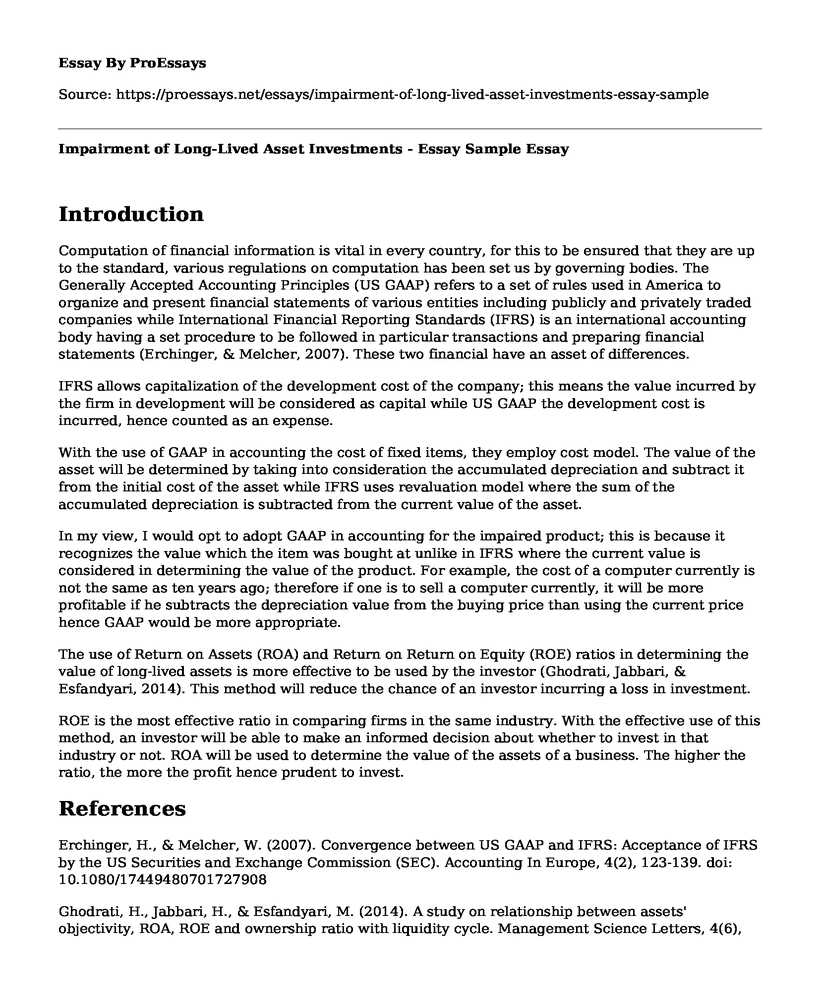Introduction
Computation of financial information is vital in every country, for this to be ensured that they are up to the standard, various regulations on computation has been set us by governing bodies. The Generally Accepted Accounting Principles (US GAAP) refers to a set of rules used in America to organize and present financial statements of various entities including publicly and privately traded companies while International Financial Reporting Standards (IFRS) is an international accounting body having a set procedure to be followed in particular transactions and preparing financial statements (Erchinger, & Melcher, 2007). These two financial have an asset of differences.
IFRS allows capitalization of the development cost of the company; this means the value incurred by the firm in development will be considered as capital while US GAAP the development cost is incurred, hence counted as an expense.
With the use of GAAP in accounting the cost of fixed items, they employ cost model. The value of the asset will be determined by taking into consideration the accumulated depreciation and subtract it from the initial cost of the asset while IFRS uses revaluation model where the sum of the accumulated depreciation is subtracted from the current value of the asset.
In my view, I would opt to adopt GAAP in accounting for the impaired product; this is because it recognizes the value which the item was bought at unlike in IFRS where the current value is considered in determining the value of the product. For example, the cost of a computer currently is not the same as ten years ago; therefore if one is to sell a computer currently, it will be more profitable if he subtracts the depreciation value from the buying price than using the current price hence GAAP would be more appropriate.
The use of Return on Assets (ROA) and Return on Return on Equity (ROE) ratios in determining the value of long-lived assets is more effective to be used by the investor (Ghodrati, Jabbari, & Esfandyari, 2014). This method will reduce the chance of an investor incurring a loss in investment.
ROE is the most effective ratio in comparing firms in the same industry. With the effective use of this method, an investor will be able to make an informed decision about whether to invest in that industry or not. ROA will be used to determine the value of the assets of a business. The higher the ratio, the more the profit hence prudent to invest.
References
Erchinger, H., & Melcher, W. (2007). Convergence between US GAAP and IFRS: Acceptance of IFRS by the US Securities and Exchange Commission (SEC). Accounting In Europe, 4(2), 123-139. doi: 10.1080/17449480701727908
Ghodrati, H., Jabbari, H., & Esfandyari, M. (2014). A study on relationship between assets' objectivity, ROA, ROE and ownership ratio with liquidity cycle. Management Science Letters, 4(6), 1341-1352. doi: 10.5267/j.msl.2014.4.007
Cite this page
Impairment of Long-Lived Asset Investments - Essay Sample. (2022, Dec 04). Retrieved from https://proessays.net/essays/impairment-of-long-lived-asset-investments-essay-sample
If you are the original author of this essay and no longer wish to have it published on the ProEssays website, please click below to request its removal:
- An Evaluation of the End of Behavioral Finance
- Irrevocable Trust on Gift Tax and Estate Taxes Essay Example
- Economic Implications of Cloud Computing Essay Example
- Essay Sample on Experience Filing Taxes for Low-Income People
- Essay Sample on Importance of Both Credit History and Credit Score
- Buying a House? Here's What You Should Know - Research Paper
- Essay Example on Clinic's Total Profit Margin & Net Income: $1.5M







